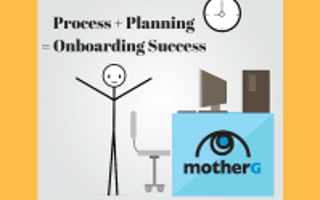At MotherG we are all about process. This includes having well thought-out strategic processes in place when a new employee joins our team to get them on board and up and running. Employee orientation often meant presenting the new hire with a training manual, a desk, forms to fill out and showing them where the kitchen and bathrooms were located.
However, today’s employee onboarding entails so much more. It is a more holistic process that consists of the transition time starting from day one as a “newbie” and assimilating and integrating into the corporate culture to working at full capacity in their new role.
Why are internal onboarding processes important?
First, it’s better for the bottom line. Reducing the amount of time it takes for an employee to get settled, situated and working results in quicker profits. You don’t want your newest talent to waste time wondering what to do, where to do it and why. Be clear about what is expected job-wise, and point out who they can approach about questions, support and assistance. Make sure expectations are established and boundaries are set from day one.
A successful onboarding program begins before the first day. Make sure your processes are in place before you hire to reduce administrative and management time. Create a master checklist with tasks, anticipate new hire questions and have answers prepared. Also, have all required documentation ready ahead of their first day.
Think about the next steps from an employee’s point of view:
1. What do I need to know before I start?
This is the administrative aspect of bringing on the new hire: The forms, policies, meetings with human resources and other key staff. This nuts-and-bolts stage can cover benefits, insurance coverage, insurance hours of operation, holidays, location of office supplies, how birthdays are celebrated and everything in between.
2. Who do I work for?
Hopefully, your new hire has already done their research on your company and has read about the company’s history, mission, values, products and services. Now is the time to explain who your company is in depth. Discuss how your company built its vision. Talk about its brand. Talk in depth about the company culture: How people work and relate to each other, important policies and how they support the company culture.
Making sure your new hires fully understand your company culture is perhaps one of the most critical stages of onboarding. At MotherG we spent a solid year defining, tuning and challenging what the team felt were our core values. They now permeate all aspects of our organization, starting with hiring, through rewarding, managing, and training. If someone does not align with the core values, they will not align with the company.
3. Who do I work with?
Assign a buddy and have them give the new hire a tour, make introductions and let them know who does what. If you work for a large company, names at desks, posted on doors and cubicle walls can be very helpful to those who may be overwhelmed with all the “newness” of their new job. Let them know to whom they can go to for support whether it’s for IT, office supplies or advice about their job.
4. What do I do?
Review the job descriptions, goals and expectations. Make sure all the proper processes are in place for your new hire to get the right training to do his/her job. Let them know what they can expect in terms of professional development program, ongoing education and training.
A few more tips:
- Have a schedule and adhere to it.
- Assign personnel and hold them accountable. At MotherG, we have an onboarding engineer who is in charge of acclimating new hires into our workspace.
- Make the client / employee feel welcome, part of the family right off the bat. One company we worked with had younger staff prepare a neighborhood guide book with information about public transportation, lists of local inexpensive lunch spots, dry cleaners, retail outlets and even the best places for happy hour for new hires.
Showing employees the ropes up-front and immersing them in company culture, meetings and even social activities will make them feel welcome, engaged and invested in the company’s success from day one and increases the likelihood that employees will buy into the corporate culture and assimilate into the position. Properly executing the orientation process can greatly increase the new employee’s satisfaction and success, which reduces turnover.
There are many correlations between working with a new client and a new employee. In both cases, the individual has chosen us just as much as we have chosen them. Just as a new client has placed their trust in our service, our brand promise, and our people, a new MotherG employee will rely on our organization to provide service, keep pre-hire commitments and orient and guide them from day one throughout their career with our company.
With any luck, your new employee will be with you for the long haul. Eventually the honeymoon phase ends and real life/work begins. Actually, I take that back. It isn’t luck at all. It’s the process and planning that get you to where you are.
About the author:
Dave Davenport is the CEO of MotherG. He received his MBA from the University of Chicago and has worked in technology his entire career. You can find Dave on Google+ and LinkedIn.






